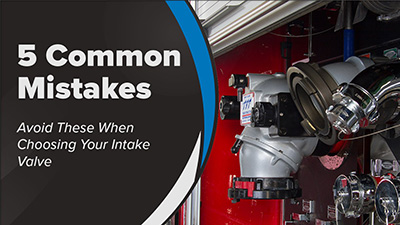5 Common Mistakes When Choosing an Intake Valve
When choosing an intake valve for your department, you want to do it right and select the best for your needs. So, are you considering all the variables you need to?
We’ve compiled a list of the five most common mistakes we see departments make when they choose one of our Ball Intake Valves. This information is valuable for any intake valve selection, so even if you decide to select a competing intake valve, be sure to avoid these mistakes!
Not Considering Your Pump Panel Layout and Size
When you’re selecting an intake valve, it’s important to consider your pump panel layout and size. Verify the overall size, depth of the panel, and whether it is behind a roll-up door. You should also get the layout information and see if there is anything nearby that may cause an obstruction. The most common obstruction is the everyday 2.5” truck discharge. These pieces of information will help you choose the right size intake valve and set up any handles or cranks so that there is no interference with operation.
We often see departments choosing their BIV based only on waterway size and the rated flow capacity. This can cause issues with fit and create difficulty with closing a roll up door, lead to the intake valve sticking out past the running boards, or create obstructions to proper use.
The bottom line: make sure you consider the size and layout of your pump panel before deciding on an intake valve.
Ignoring Your Water Source and Necessary Waterway Size
Your water source is another important consideration when choosing an intake valve. Do you do a lot of drafting from static sources? Does your water supply come from well-fed municipal hydrants? Do you do both regularly?
As you select an intake valve, you should consider where your water is coming from and how that may affect your needs.
For example, a department that drafts from large static sources regularly will probably want the largest possible waterway to limit friction loss and supply as much water as possible to their pump. A department that works from portable tanks and smaller static water sources may not want to move water as quickly and could benefit from a smaller waterway, but that ultimately depends on their normal operating procedures.
Which TFT BIV is best for drafting? Watch Ask TFT to find out!
Forgetting About Water Quality
Many people do not consider the quality of the water they will be flowing through their intake valve. Are you a department that drafts from a saltwater source sometimes? Is the water you have access to brackish or full of sediment?
Water quality can affect the life span of your intake valve, the operation, and the necessary maintenance over time.
If you know your water quality is not great, or that you are going to use a saltwater source, you will want to consider the materials your intake valve is made of more carefully. Double check that the materials are corrosion resistant. Better yet, check to see if the manufacturer has an extended warranty specific to corrosion, which will benefit your department. If you will use the intake valve with saltwater, check the manual or talk with your dealer to ensure saltwater is safe to use with it.
In either case, you will want to understand the maintenance needed after use with a poor water source. Will the intake valve need flushed with fresh water or cleaned afterward? Will it cause added wear and tear on any pieces? Make sure you get a good understanding of how water source will affect the intake valve you choose.
Not Considering Your Weather and Temperatures
Deciding on a type of intake valve – whether a ball intake valve, butterfly valve, or piston valve – can be affected by the weather of your response area. If you deal with prolonged freezing temperatures where ice can form, you may want to avoid styles of valves that leave water sitting inside of the valve. If ice builds up it can cause damage to your valve or impact operation on the fire ground.
If the station your trucks sit in is not climate controlled, or you regularly have calls that require your apparatus to be out for extended periods, you may experience more issues. Shorter calls and climate-controlled buildings can minimize the likelihood of ice forming inside your intake valve, but the safest choice is to make sure your valve of choice does not leave resting water inside the valve that is prone to freezing.
Not Thinking About Available Personnel
The operating style of your intake valve may depend on your department’s staffing levels. Do you have enough firefighters to run a manual intake valve? Do you need a remote-control model so that someone can more easily multitask?
For volunteer departments this question can be especially tricky. Think about how many members regularly respond to your calls. At your lowest response rate, do you have enough members to effectively run your intake valve and other fireground operations?
Considering your staffing or response levels can help you decide what type of operational method is best suited to your department.
Conclusion
There are a lot of things to consider as you choose an intake valve for your department. Here we’ve compiled five things that are easy to forget when you’re exploring options. Make sure to consider each one as you make your choice to avoid complications in the future!
How do you choose the right ball intake valve? Read more here or watch our Ask TFT episode!
